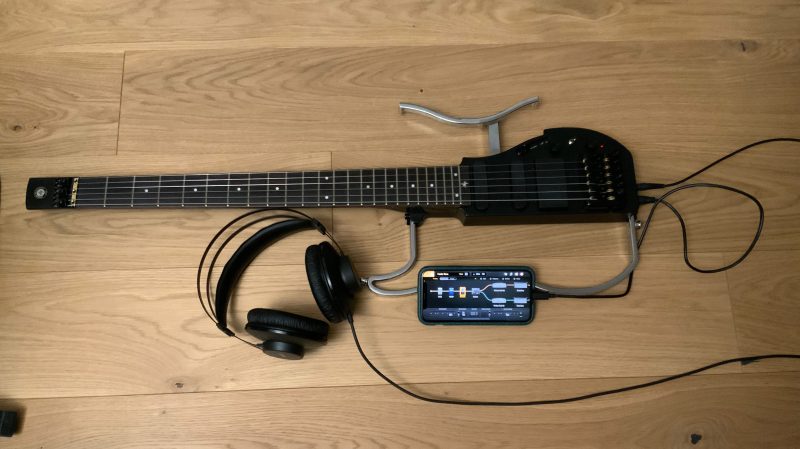[Courcirc8] was a big fan of the ALP AD-80, with the travel guitar being a surprisingly competent instrument despite its folding form-factor. However, the onboard headphone amp left something to be desired, so it was time to get hacking.
To achieve better audio output, [courcirc8] decided to purchase an iRig HD 2 guitar interface, and installed it inside the body of the compact guitar. The original volume pot on the guitar was instead spliced into the iRig circuit, and a switch hooked up to allow the guitar to output clean tones to an amp or the digital audio output of the iRig instead. It’s a tight fit inside, but it all nestles in there rather neatly when finished.
The result is a compact guitar that has a capable digital FX platform built in to the body; all one has to do is hook up a smartphone to gain access to a broad selection of software effects. It makes the guitar much more of a Swiss Army knife when playing on the road.
We’ve seen others before installing guitar effects into the instrument itself; it remains perhaps one of the best ways a hacker can express themselves with a completely individual instrument!
















I love the idea.
However, this kind of ruins it:
> all one has to do is hook up a smartphone to gain access to a broad selection of software effects.
… I would prefer making music to handling a “smart” phone. If I need a smart phone to play guitar, something has gone very, very wrong.
To me, the idea is great (and has been done before, which however never is a reason to not do it again), but the choice of a “smart” phone driven component makes it basically the only wrong hack one can do to a guitar.
I can only disagree. [Courcirc8] had some requirements and they have achieved their goal. Anyway what’s your complaint, an electric guitar always needs amplification.
That entire comment contradicts itself. You love the idea but not using a phone?
Would you still be keen on the idea if you were able to use traditional pickups but instead of a smartphone, you had a SBC that would run amp / modelling sim and had a decent input / output circuit?
I’ve been thinking of using a SBC to run a sort of rig like this but for FX only and to output to amplifier, but unless one got a x86 SBC, you’d have a bunch of overhead running the particular software which is usually all Windows and x86 based.
Well… making software emulation requires some DSP. Using a smartphone avoid having to buy expensive dedicated hardware. Purists might prefer “real amps” with tubes, but it is rarely as portable! ;) Thanks anyway for the comment.
I have no problem with the smartphone aspect of it, they are just a common way of interfacing with things soft. But the phone should be in the guitar in a visible position otherwise it’s a dongley thing.
I have a portable slide e-bow instrument with a Digitech effects unit mounted on as well as the speaker and battery. I can mount a tablet and play both at the same time, so I am ready for this setup.
I looked into the iRig unit and interface, while small and high def I loathe visual fakes and virtual lighting on brand name effects units and amp heads all with different “knobs” to have to “turn”. If this slim piece of hardware could run Rakarrack which is free loaded with 40 detailed effects with up to 10 chained and sports a sensible modern software GUI I’d jump at $80.
Fascinating hack, well done @Courcirc8!
I went through the same process over the holidays, trying to place the iRig HD2 PCB in the ALP AD80 guitar, but I couldn’t get the PCB to fit properly. Instead, I opted for placing an iPhone SE and the iRig HD2 on a strap, and connecting to the guitar via a short cable. I considered 3d printing a custom back cover for the guitar, with a cavity for the phone but didn’t get around to it.
I also tried a few other approaches:
(1) the combination of an iPhone 6s and a 1/4″ mono jack guitar to lightning cable that I found on Amazon. The iPhone 6s was necessary because of its audio jack: the particular cable did not support audio out. The 6s was plenty powerful for running Bias Fx 2, but the quality was definitely worse compared to the HD2.
(2) to remove the cable from the iRig HD2 to the headphones, I tried to use a “Donner DZ Wireless Guitar Transmitter Receiver”. On the positive side, it was stereo and there was no latency I could perceive. On the negative side, it audio output was not line-level, so headphones volume was very low.
(3) I used the same “Donner DZ” as it was originally intended, as a guitar interface, and placed the iPhone SE and the iRig HD2 on the headphones band. This was the best quality, least hustle setup, but it just looked silly.
In the end, I got a Boss Waza Air: The available amps and effects are limited compared to the Bias Fx 2, but it is the most straightforward setup, so I end up using this more frequently.
Also, reading up on Bluetooth Low Energy, it is apparently possible to have a 5ms *data* connection that could support a single uncompressed 24-bit/48KHz channel, but the available BT audio codecs have too high latency. LE audio will eventually provide low-latency BT, but I doubt it would be 24-bit/48KHz quality.
You’d think we’d have a good solution for this very common case setup by now.
I like the idea of the alp guitar, I wish I’d bought one a few years ago when AliExpress were selling them for £150. Once they become popular, their price tripled.